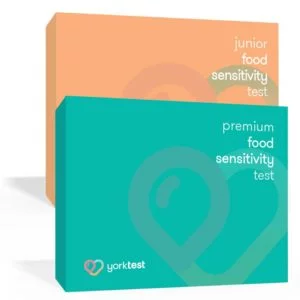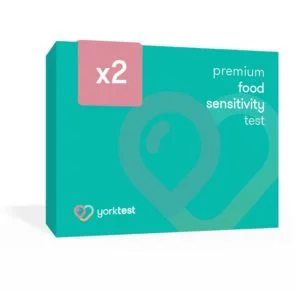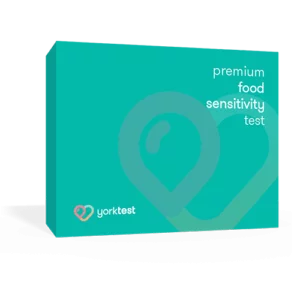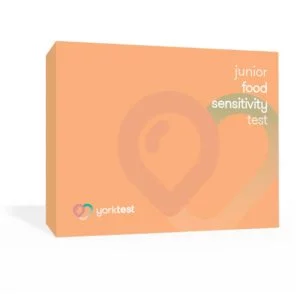You can take a take a food sensitivity test at home by ordering a testing kit online. The kit will be mailed out to you within a few days, then you can collect your blood sample and ship it back to be analyzed – simple!
A YorkTest food sensitivity test starts and ends its journey at our in-house laboratory. Once you’ve placed your order, we will send you a kit containing everything you need to supply us with a small blood sample. This involves a simple prick of the finger with a small, sterilised lancet, which you can carry out in the comfort of your own home, without the need of a nurse/practitioner to perform a blood draw. You then post this sample to our laboratory in the pre-paid envelope provided and we’ll do the rest.
Let’s take a look in a bit more detail at what’s included in a test kit, how long a food sensitivity test takes, how to take your sample, how you get your results, and how reliable food sensitivity tests are…
What’s included in a food sensitivity test kit?
Once you have placed your order, you will receive your kit containing:
- A return envelope (no shipping costs)
- 2x sterile, single-use lancets
- 1x absorbent wand
- 1x absorbent wand container
- 1x adhesive plaster
- A cleansing wipe
- A larger container in which to return the sample


How long does a food sensitivity test take? And where should I take the test?
It is important to read all the necessary explanatory information before you start taking your test. Take as long as you need for this step to read the instructions and get ready to collect your sample.
Then, set aside approximately 15 minutes in a quiet environment to take the blood sample.
It is helpful to have a hard surface – like a table – to rest your finger on when taking the sample.
Instructions for activating and taking your test
When you receive your kit, you will need to activate your test on our Wellness Hub. To do this, enter the 8-digit code provided on the larger plastic blood collection tube.
The Wellness Hub is where you will be able to see the progress of your test and access your results.


Once you have activated your test online, you can then take the finger-prick blood sample in the comfort of your own home:
- Ensure that your hands are clean and warm by soaking them in warm water for 2 minutes – this makes it easier to collect the blood sample.
- Thoroughly dry your hands with a clean towel and wipe the top of your finger with the alcohol-free cleansing wipe (ideally the 4th finger of your less dominant hand).
- Twist off the lancet top and rest your finger on a firm surface.
- Press the lancet down on the tip/side of your finger until you hear a click, the click means the single-use lancet has been activated.
- Rest the absorbent wand against your finger to absorb the blood.
- Place the blood-saturated wand in the container provided, then place this in the pre-paid envelope and mail back the same day.
It’s really important that you return the sample on the same day that you collect it. This ensures we receive your sample quickly and can begin analysis – blood samples which are too old cannot be analyzed properly.
How to get your food sensitivity test results
Once we have received your sample, our in-house team of experts will analyze and test it for food-specific IgG reactions.
You’ll receive your results via email within 7 days. Along with your results, you’ll find guidance on how to interpret them and an easy-to-understand traffic light system which also shows a numerical score for your reactivity to each food/drink ingredient tested.
You will have access to your results via your YorkTest Wellness Hub account. Here, you will also be able to access our Food Sensitivity Test Results Guidebook. This is an easy-to-follow step-by-step guide which explains next steps for managing any food sensitivities identified and help get you started on your road to wellbeing.


How accurate are food sensitivity test kits?
The accuracy of a food sensitivity test depends on the methodology of the test.
At YorkTest, we define food sensitivity and food intolerance testing as ‘looking for any food-specific IgG reactions in the body’.
IgG (Immunoglobulin G) is an antibody. After collecting your sample, we run tests in our laboratory to see which foods are causing any IgG reactions. There are four types of IgG (IgG1, IgG2, IgG3 and IgG4).
Some food sensitivity tests only measure IgG4 levels. But at YorkTest, we measure all four.
There is a complex relationship between the four IgG subtypes. Meaningful results can only be determined by testing for all four subtypes together.
IgG1, IgG2 and IgG3 are all capable of causing inflammation which could contribute to symptoms. IgG4 antibodies are only present in low levels and its presence does not relate directly to inflammatory reactions. Therefore, testing only for IgG4 antibodies in foods severely limits the accuracy of pinpointing those ingredients that are causing significant reactions and could be contributing to your symptoms.
Read our full What is IgG? Guide for more details on IgG.
The reproducibility rate of our tests is over 98%. This means that when we take two samples from the same person at the same time and test both samples, the results will correlate with each other more than 98% of the time.
We test for all four subtypes of IgG, analyzing your sample for reactions to over 200 food and drink ingredients. This reduces the risk of any reaction being missed.
As well as being highly accurate, you can have peace of mind when reading the results of your food sensitivity test, knowing that so many foods have been tested.
If you have any further questions about how to take your food sensitivity test, please contact our customer service team on [email protected]. They will be more than happy to help.











